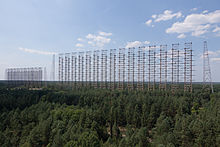

Duga (Russian: Дуга́, lit. 'arc' or 'curve') was an over-the-horizon radar (OTH) system used in the Soviet Union as part of its early-warning radar network for missile defense. It operated from July 1976 to December 1989. Two operational duga radars were deployed, with one near Chernobyl and Liubech in the Ukrainian SSR (present-day Ukraine), and the other in eastern Siberia (present-day Russia).
The duga system was extremely powerful, reaching over 10 MW, and emitted in the shortwave radio bands. It was given the nickname Russian Woodpecker by shortwave listeners for its emissions randomly appearing and sounding like sharp, repetitive tapping noises at a frequency of 10 Hz.[1] The random frequency hops often disrupted legitimate broadcasts, amateur radio operations, oceanic, commercial, aviation communications, and utility transmissions, resulting in thousands of complaints by many countries worldwide. The signal became such a nuisance that some communications receivers began including "Woodpecker Blankers" in their circuit designs.[2]
The unclaimed signal was a source of speculation, giving rise to theories such as Soviet brainwashing and weather modification experiments. However, because of its distinctive transmission pattern, many experts and amateur radio hobbyists realized it was an over-the-horizon radar system. NATO military intelligence had already given it the reporting name STEEL WORK or STEEL YARD, based on the massive size of the antenna, which spanned 700 metres (2,300 ft) in length and 150 metres (490 ft) in height.[3] This massive structure formed a phased array and was necessary in order to provide high gain at HF as well as facilitating beam-steering, though it is unconfirmed whether the latter was actually used in normal operation. While the amateur radio community was well aware of the system, the OTH theory was not publicly confirmed until after the dissolution of the Soviet Union.
- ^ David L. Wilson (Summer 1985). "The "Russian" (sic) Woodpecker... A Closer Look". Monitoring Times. Archived from the original on 8 April 2019. Retrieved 8 April 2019.
- ^ "americanradiohistory.com" (PDF). Archived (PDF) from the original on 11 July 2021. Retrieved 11 April 2020.
- ^ "cnn.com". CNN. March 2019. Archived from the original on 27 June 2020. Retrieved 27 June 2020.